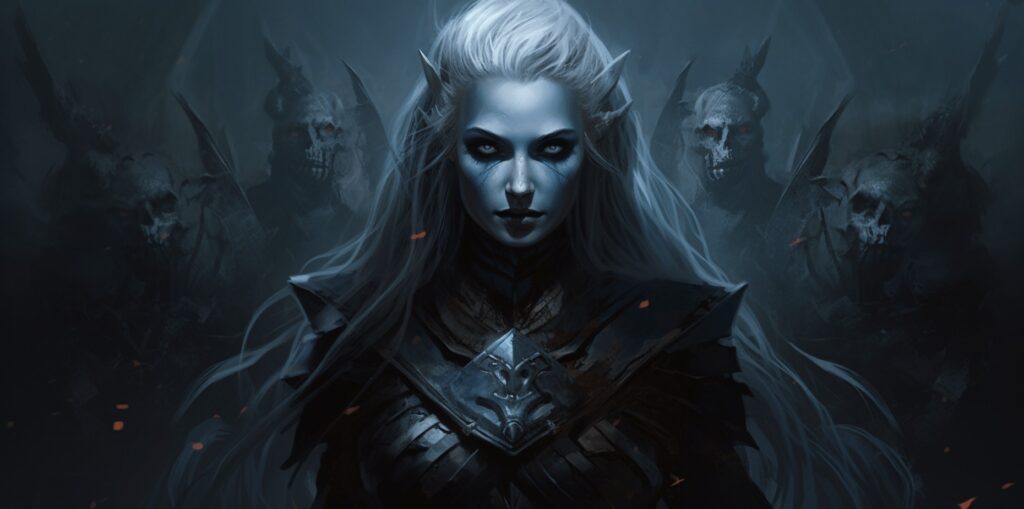Creatures in Norse mythology, Elves, Norse Mythology
Unraveling the Enigmatic World of Norse Mythology: Dark Elves
Norse mythology, a tapestry of gods, heroes, and mythical realms, has captivated the imagination of people for centuries. While figures like Thor and Odin are widely known, there exists a lesser-known but intriguing group of beings known as dark elves, or “Dökkálfar” in Old Norse. In this article, we embark on a journey to explore the hidden realm of dark elves and uncover their significance within the rich tapestry of Norse mythology.
Norse Mythology – An Overview
Norse mythology, originating from the ancient Germanic tribes of Northern Europe, encompasses a diverse array of gods, goddesses, and fantastical creatures. The mythological beliefs were an integral part of the ancient Norse culture, influencing their daily lives, rituals, and understanding of the world around them. Central to this belief system was the cosmology of the Nine Worlds, interconnected through the mythical World Tree, Yggdrasil.
Dark Elves – A Closer Look
Among the myriad mythical beings populating the Nine Worlds, dark elves stand out with their unique characteristics and elusive nature. Often distinguished from the light elves (“Ljósálfar”) by their darker appearance and demeanor, dark elves inhabited their own realm, known as Svartalfheim. Unlike their ethereal counterparts, dark elves were known for their craftsmanship, particularly in metallurgy and crafting powerful weapons.
Descriptions of dark elves in Norse mythology are shrouded in mystery, leaving room for interpretation and speculation. Some sources depict them as reclusive, dwelling in underground caverns, while others describe them as mischievous tricksters or wise beings with a deep understanding of ancient knowledge.
The Duality of Elves in Norse Mythology
The distinction between dark elves and light elves reflects the dualistic nature often found in mythological systems. Light elves, associated with brightness, lived in Alfheim, embodying beauty, joy, and benevolence. On the other hand, dark elves, dwelling in Svartalfheim, embodied elements of darkness and mystery.
Despite their differences, both groups of elves played significant roles in Norse mythology. They interacted with gods, humans, and other mythical beings, showcasing their influence on the overall narrative and cosmology.
Notable Dark Elves in Norse Legends
The annals of Norse mythology are rife with captivating tales featuring dark elves. One such story revolves around Alvíss, a dwarf who seeks to marry Thor’s daughter. In an unexpected twist, Thor engages Alvíss in a battle of wits to delay the marriage until sunrise when the cunning dwarf is turned to stone by the first rays of sunlight.
The mythical dwarves of Norse mythology are also often associated with dark elves due to their shared realm of Svartalfheim. These skilled artisans crafted Mjölnir, Thor’s iconic hammer, and other legendary artifacts for the gods, reflecting the importance of dark elves’ craftsmanship.
Dark Elves and the Realms of Yggdrasil
Within the vast cosmology of Yggdrasil, the World Tree, dark elves held a unique position in the underground realm of Svartalfheim. The precise location of Svartalfheim remains open to interpretation, but it is generally considered to be one of the Nine Worlds situated beneath the surface of the earth.
Dark elves, in their realm of Svartalfheim, were responsible for shaping the raw materials found in the earth, creating precious metals and intricate works of art. Their craftmanship was highly regarded by the gods, making them essential contributors to the well-being of the cosmos.
The Legacy of Dark Elves in Modern Culture
The allure of Norse mythology, including dark elves, has left an indelible mark on modern culture. From literature to movies, video games, and art, the influence of these enigmatic beings continues to captivate audiences worldwide.
In contemporary literature, authors draw inspiration from dark elves to create compelling and complex characters. These interpretations often explore the duality of their nature, portraying them as both malevolent and wise beings with vast knowledge.
Dark elves have also made their mark in popular culture through various forms of media. In movies like “The Lord of the Rings” and “The Hobbit” franchises, dark elves are portrayed as a distinct and mysterious race with their own unique abilities and attributes.
Moreover, in the world of gaming, dark elves have become iconic characters in titles like “The Elder Scrolls” and “World of Warcraft,” where players can immerse themselves in the captivating realms of Norse mythology.
Conclusion:
The world of Norse mythology is a treasure trove of captivating stories and mythical beings, with dark elves standing as enigmatic figures that continue to intrigue and inspire. Through exploring their origins, characteristics, and significance within the Norse pantheon, we gain insight into the cultural beliefs and values of ancient Norse societies.
The legacy of dark elves lives on in modern culture, where their influence can be seen in literature, art, movies, and gaming. As we uncover the secrets of these mysterious beings, we are reminded of the enduring allure and timeless appeal of Norse mythology, a realm where the lines between light and darkness blur, and where the fantastical and the profound merge into captivating tales of old.

